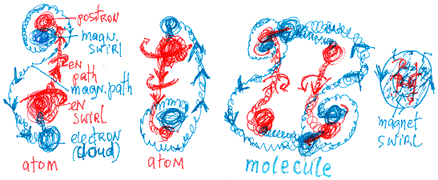The Structure of the Hydrogen
Atom
(Continued —
Page 7)
Printer-Friendly
Version
A black hole that attracts a considerable amount of energetic
matter can create more than one “storage” swirl.
This phenomena also takes place in concentrated energetic
atoms.  For
example, hydrogen atoms in frigid water lose energy and are
less active, and their energetic matter is consequently more
concentrated. Therefore, they create more compact neutron
loops, deuteriums, and tritiums. These particular deuterium
atoms are toxic to living formations, as they are incapable
of providing energy to “living tissues” (like
the original, highly-energetic hydrogen atom). For
example, hydrogen atoms in frigid water lose energy and are
less active, and their energetic matter is consequently more
concentrated. Therefore, they create more compact neutron
loops, deuteriums, and tritiums. These particular deuterium
atoms are toxic to living formations, as they are incapable
of providing energy to “living tissues” (like
the original, highly-energetic hydrogen atom).
Highly-energetic hydrogen atoms prevent neutron formations
from developing stable storage “tanks” in which
 to
conserve energetic matter. Instead, as mentioned above, it
apparently produces a row of small tanks that expel excess
energy via the neutron’s rope in which energy circulates
perpendicular to the proton and positron. The energetic properties
face towards the inside of these formations (in contrast to
the positron’s properties that face towards the outside). to
conserve energetic matter. Instead, as mentioned above, it
apparently produces a row of small tanks that expel excess
energy via the neutron’s rope in which energy circulates
perpendicular to the proton and positron. The energetic properties
face towards the inside of these formations (in contrast to
the positron’s properties that face towards the outside).
The hydrogen atom, like the photon, is highly energetic and
is capable of transferring an extensive amount of energy,
but its storage capacity is limited. However, in a molecular
formation with other atoms, hydrogen atoms create highly-energetic
“living” swirls (this process is examined comprehensively
in the article on life formations):

In fact, hydrogen is even more vital to living formations
than oxygen: in volcanic regions deep beneath the ocean surface,
many organisms survive without any access to oxygen. The presence
of high-energy hydrogen in these locations reinforces the
significance of water (H2O) as far as living formations are
concerned.
Dr. Chaim Tejman, Copyright©
2003. All rights reserved.
[Index]
[Introduction]
[Summary] [Book]
[Wave Formation] [Photons]
[Gravitation] [Time]
[Life] [Cancer]
[Fundamental Force] [Gender/Why
Sex?] [Sexual Reproduction]
[Schrodinger & Heisenberg]
[Creation] [Supernova]
[Dark Matter & Astronomy]
[Speed of Light] [Cloud
Formations] [Natural Disasters]
[Global Warming] [Thermodynamics]
[Backward Time] [Quantum
Mechanics] [Compton Effect]
[Equations] [Predictions]
[Academic Correspondences] [Contact]
[Links] [Mysteries] |